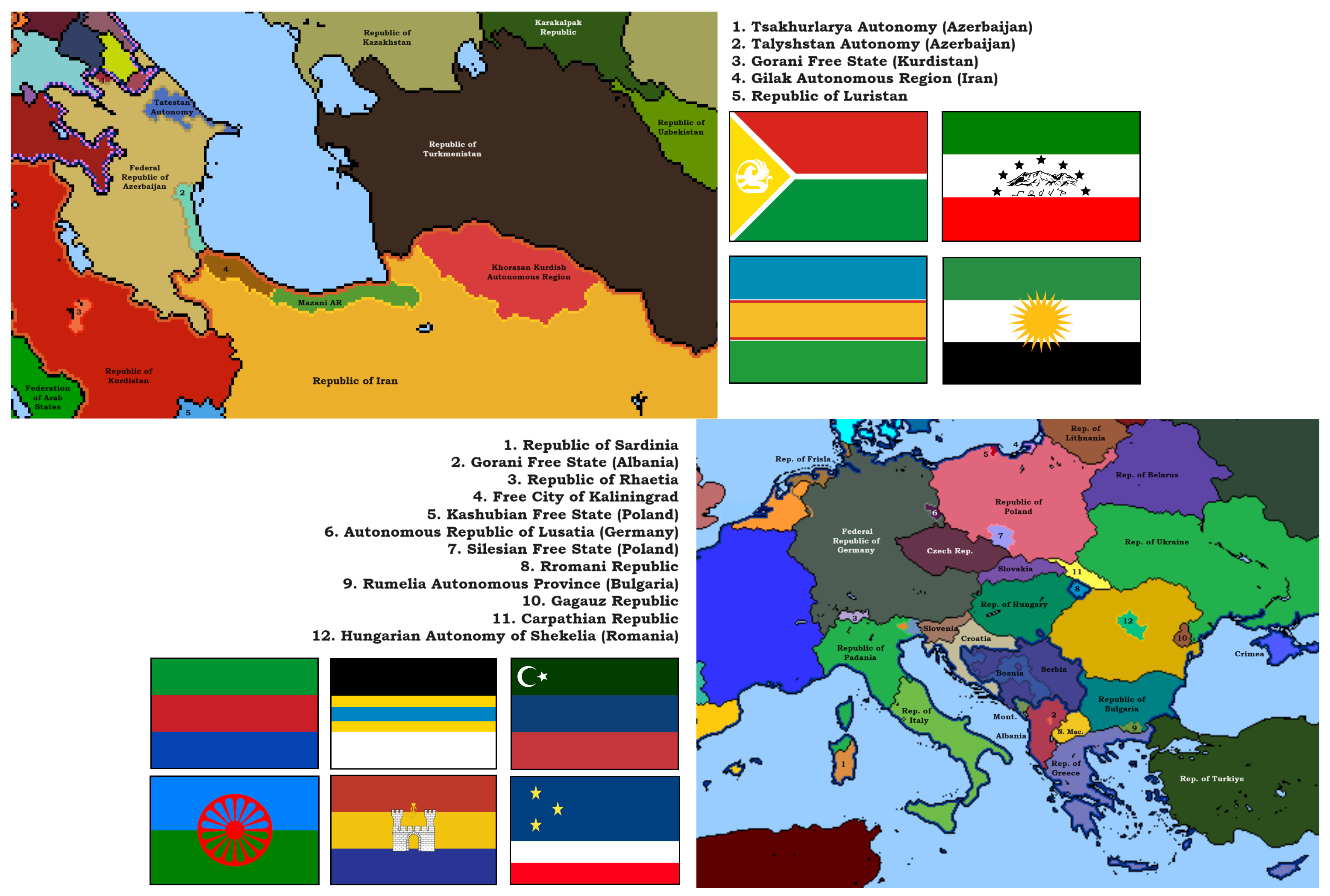HOME | DD
 Peter-MacPherson — AWP | Map and Flag Updates (11/2/23)
Peter-MacPherson — AWP | Map and Flag Updates (11/2/23)

#alternatehistory #alternatetimeline #alternateuniverse #azerbaijan #bosnia #bulgaria #gypsy #iran #kurdistan #macedonia #persia #persians #romani #romania #serbia #turk #ukraine #fyrom #rumelia #rromani #alternatehistorymap #gagauz #gorani #talysh #talyshstan #korasan #tatestan #tatistan #albania #alternate_history
Published: 2023-11-02 22:11:34 +0000 UTC; Views: 7146; Favourites: 47; Downloads: 4
Redirect to original
Description
The four-faction battle that was the Third Balkan War, nevermind the First and Second Conference of Bonn, changed the majority of the European landscape, as well as the lower Caucasus-- due to the latter half of the Third Balkan War and the Caucasus Interventions intersecting with the Fifth Nagorno-Karabakh War.With the foundations of the United Caucasus Military Compact within the European Union, as well as the foundations of the League of Zerand echoing the policies and motivations of the European Union, the nation of Azerbaijan was now trapped and without major allies, especially due to the Azeri Free Republic in Iran uniting with Azerbaijan after the fall of the Islamic Republic, and the European Union now absorbing their greatest enemy, Armenia. In order to sue for peace, Azeri portions of Dagestan were gifted to the young nation alongside other peace terms during the Treaty of Mingecevir in 2050. Azerbaijan has maintained the current borders shown on the map since then, with only the nations of Kazakhstan and serving as their foremost ally, although also maintaining stable diplomatic relations with Israel, England, and african nations such as Futajalon, Pan-Mande, and Zenaga. Although in good relations with Zenaga, Azerbaijan has decidedly stayed out of the Second English Civil War due to wanting to maintain good relations with North American and western European trade networks. By 2075 the Azeri Manat's inflation rate had reached a point of economic crisis, and in 2080, the Azeri government reached a tentative deal with the League of Zerand, which allowed them to employ the use of the League's unified currency, the Darik. It should also be noted the only member of the League of Zerand not to employ the use of the Darik was Ossetia, which employed the use of the Euro.
The Karakalpak Republic won it's freedom from Uzbekistan around the 2070s, in which time the Uzbek army had been significantly weakened from taking portions of the failing state of Afghanistan during it's joint occupation as part of the rise of the Pashtunistan state after the dissolution of Pakistan, which also involved the countries of Tajikistan and Iran, and lay the foundations for what would soon become the League of Zerand. Karakalpak would go on to declare an oath of diplomatic neutrality, however still maintained a powerful defense force. There are factions within Uzbek and Kazakh politics that desperately seek to reclaim the region as part of some irridentist bullshit, but so far Karakalpak's independence has been largely supported by the League of Shanghai.
the Gorani Free State in Albania, not to be confused with the Gorani Free State in Kurdistan, is made up of an ethnoreligious group of Muslim Yugoslavs, known as the Gorani, which fall in close relation to Macedonians and Serbs. Many Torbeshi (Muslim Macedonians) also would move into this state and gradually assimilate into the Gorani populations, after Macedonia's population shift following the Second Conference of Bonn (after Albania officially absorbed Kosovo from Albania).
The idea of a Rromani state from so-called civil rights leaders was somewhat encouraged due to the similar acts of repatriation being shown in returning the displaced populations of Crimean Tatars and Circassians to their rightful places on the Black Sea, as well as the encouragement Armenia received from the general Populus during the Kars Crusade. Although there were many Rromani who were against the possible repatriation into their own homeland, the arguable-dictatorship of an increasingly federalized European Union during that general period of unrest in the mid-21st century, wasn't going to give them much of a choice. To the absolute glee of all but some Romanians and Hungarians local to the area, Rroma were stripped from any homes they'd had and forced onto this spit of land, barred from joining the EU by any means necessary, and were forced to build themselves up from scratch, surrounded on all sides by militant border patrols.
Although it had been initially met with doom and gloom, the Rromani Republic was able to piece itself together, finding common ground in their language and culture, though perhaps not so much their religion. Only the Gaelic world had ever shown sympathy to the Rroma, sending care packages, sums of money, or transplanting businesses. Having been forced to leave the life of travelers and wanderers behind by a harsh and uncaring world, the Rroma identity would begin to spiral into radical leftism. Rroma migrants to North America in the 2090s would be met with much more sympathy, especially in Kingsland, the North Atlantic Republic, New England, and the Great Lakes Commonwealth. Hindustan and the Rromani Republic would enter diplomatic negotiations in 2091.
From a Meta standpoint, I realized after a while that there being three German states after the willful absolving of Switzerland in the 2030s was kind of a stupid idea, so I rejoined them into a single entity once again. I also considered the Rumansh possibly just being absorbed as an autonomous region in Germany, but figured that perhaps any Swiss nationals could try to create a new identity in Raetia.
The flags shown on the above map correspond with, from left-to-right, Tatestan autonomy, Tsakhurlarya autonomy, the Karakalpak Republic, and the Khorasan Kurd autonomy.
The flags shown in the bottom map correspond with, from left-to-right, Rumelia autonomy, Republic of Rhaetia, Gorani autonomy, the Rromani Republic, the Free City of Kaliningrad, and the Gagauz Republic.






















